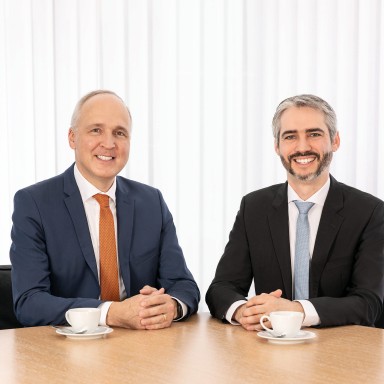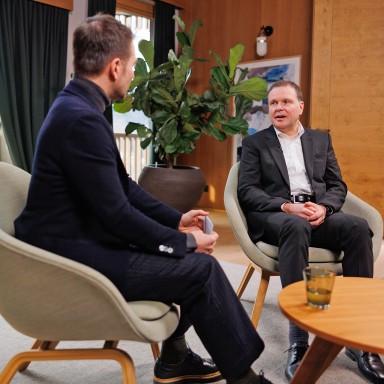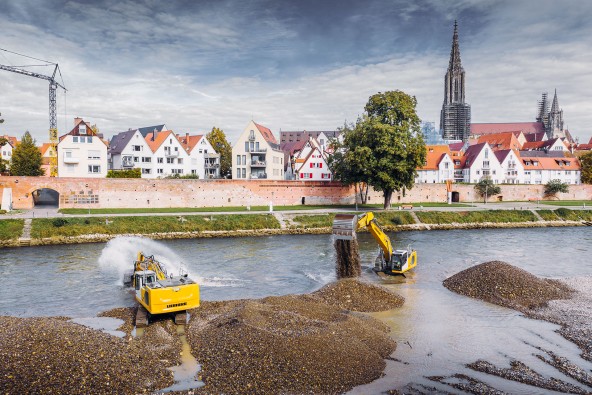
The Group in 2024
In 2024, the Liebherr Group once again achieved record revenue of €14,622 million. This represents an increase of €580 million, or 4.1 %, year-on-year.
Revenue worldwide € m
Overall economic performance
The International Monetary Fund has calculated global economic growth for 2024 at 3.2 %.
This is still below the historic average of 3.7 % for the years 2000 to 2019. During this business year, the economy grew by 4.2 % in emerging market and developing economies and by just 1.7 % in industrialised countries. The very slight increase of 0.8 % in the euro area and the even slightly shrinking economy in Germany (-0.2 %) are particularly striking. Growth in the USA was reported at 2.8 %.
There are many reasons behind the economic situation during the business year. Economic policy uncertainty has increased significantly, especially on the trade and fiscal fronts. Newly elected governments and the political instabilities in the final months of the business year have influenced pricing and unsettled the market. On top of this, there was geopolitical tension and global trade disputes.
During the 2024 business year, Liebherr reported revenue of €14,622 million, once again representing an increase year-on-year and marking a new all-time high. Business developed very differently in the various product segments: the Group achieved increases in revenue in the product segments of deep foundation, mining, mobile and crawler cranes, maritime cranes, aerospace and transportation systems, as well as gear technology and automation systems, but followed a downward trend in the other segments.
In construction machines and mining, Liebherr achieved revenue of €9,891 million, which represents a year-on-year increase of 3.5 %. This includes the earthmoving, material handling technology, deep foundation, mining, mobile and crawler cranes, tower cranes and concrete technology product segments. In the product segments of maritime cranes, aerospace and transportation systems, gear technology and automation systems, refrigerators and freezers, components and hotels, the Group generated combined revenue of €4,731 million, equating to an increase of 5.5 % compared with the previous business year.
The subdued demand in the construction industry, especially in Germany, weighed on some product segments, resulting in declining revenue. Thanks to the Group’s diversification and decentralisation, it was possible to offset these downward trends through the successful marketing of other products. Growth was primarily driven by mobile cranes, components for the aerospace product area and good orders in mining and gear technology.
Revenue performance by region
Revenue 14,622 € m
+4.1 % +580 € m
| % the previous year | € the previous year | ||
|---|---|---|---|
| Asia and Oceania | 2,719 € m | +21.8 | +486 m |
| Africa, Near and Middle East | 1,024 € m | +9.4 | +88 m |
| Central and South America | 503 € m | −6.3 | −34 m |
| North America | 2,568 € m | +5.0 | +122 m |
| Non-EU countries | 1,530 € m | +10.6 | +147 m |
| European Union | 6,278 € m | −3.5 | −229 m |
In the 2024 business year, the Liebherr Group’s revenue developed differently in the sales regions. A healthy increase in revenue was recorded in Asia and Oceania, driven by Australia and Japan. In Europe, the Group recorded a slight downward trend, despite good business in the Netherlands, Spain, Portugal and the United Kingdom. In Central and South America, revenue was also below the level of the previous year. By contrast, revenue in North America and in the Africa, Near and Middle East region increased compared with the previous business year. This was driven by the USA, Canada and South Africa in particular.
Net income
The operating result increased compared to 2023, although the finance result fell below the previous year’s level. This meant that the Liebherr Group achieved a net income of €258 million in the 2024 business year.
Employees
54,728
+1,069
| Employees | Compared to the previous year | ||
|---|---|---|---|
| Asia and Oceania | 4,790 | +248 | |
| Africa, Near and Middle East | 1,275 | +68 | |
| Central and South America | 1,933 | −51 | |
| North America | 2,516 | +226 | |
| Non-EU countries | 3,943 | −442 | |
| European Union | 40,271 | +1,020 |
The Liebherr Group’s employees are the key to its success. Their qualifications, commitment and determination to produce first-class results mean that they are the ones who decisively shape the company. As a family-run company, Liebherr is an employer with a strong tradition of partnership and teamwork based on reliability, fairness, respect and autonomy.
The number of employees in the Group grew again during the business year. At the end of 2024, Liebherr employed 54,728 people worldwide, representing an increase of 1,069 employees, or 2.0 %, year-on-year. Women represented 18.0 % of the Group's workforce at the end of the business year.
The European Union saw the largest increase in the number of employees, although Liebherr recorded a decline in employee numbers in the non-EU countries. The number of employees also fell slightly in Central and South America, but increased in North America. In the Africa, Near and Middle East region as well as in Asia and Oceania, the number of employees also rose compared to the previous year.
The Group is regarded as an attractive and reliable employer. Liebherr creates exciting professional challenges and opportunities for employees to nurture their passion for fascinating, innovative products and technologies through the diverse tasks they perform in their day-to-day work. A whole host of opportunities awaits employees starting their working life, ranging from apprenticeships and dual study programmes, through to a final thesis or traineeship opportunities.
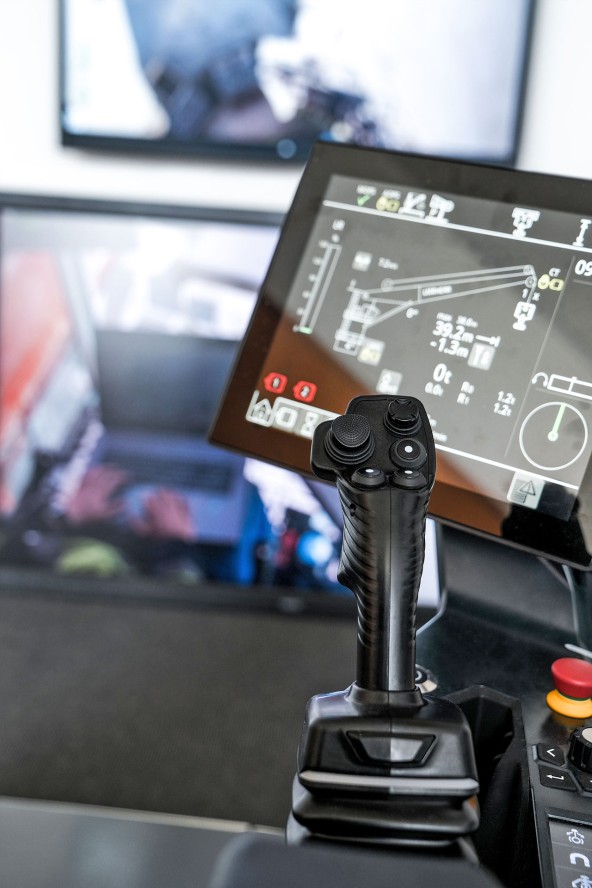
The Liebherr Remote Control System (LiReCon) as an on-site solution enables the remote control of machines without visual contact and increases safety, comfort and productivity.
Research and development
As a high-tech company, Liebherr aims to play a major role in advancing technological innovation. In the 2024 business year, the Group therefore invested €666 million in its research and development activities. A large part of this was devoted to developing new products, numerous research projects in collaboration with universities, colleges and research institutes were also conducted. The areas of alternative drives, autonomy and digitalisation remained focal points of research and development, which saw existing technologies refined and numerous new machines, components and solutions added to the product programme.
In the business year, the Group continued its activities in the field of alternative drives. With its open approach to technology, Liebherr supports its customers in achieving future emissions targets. For example, it presented the world’s first prototype of a large wheel loader with a hydrogen engine. This engine of the L 566 H is also made by Liebherr and is manufactured in Bulle (Switzerland). In the field of electric drives, Liebherr started series delivery of the LPO 100 mobile energy storage system and the development of the even more powerful LPO 600 prototype. Liebherr also worked on creating hybrid versions of its machines. For example, the hybrid crane LTC 1050-3.1E was introduced, which can be operated on the construction site using battery power alone.
In aerospace, the Group turned its attention to the further development of pioneering solutions. The portfolio was enhanced with next generation flight control computers and modular electromechanical actuators. Milestones were also reached in the field of 3D printing.
In September 2024, Liebherr and Fortescue announced the historic extension of their partnership at MINExpo in Las Vegas (NV/USA). The Group’s largest order comprises the delivery of 475 zero-emission mining machines, of which 360 are models of the autonomous, battery-electric mining truck T 264. This formed the focus of Liebherr Mining’s development activities in 2024. Liebherr and Fortescue are jointly developing and validating zero-emissions mining solutions, which will lead to a large-scale zero-emissions mining ecosystem by 2030.
In other product segments, the Group also worked on extending its portfolio in the field of autonomy and automation. Accordingly, the LiReCon teleoperation unit is now ready for series production and, in the gear technology and automation systems product segment, Liebherr received an award for the automation system for disassembly of used batteries. Liebherr continued its research into the next step for autonomous construction machines – a milestone that will be presented at Bauma 2025.
In order to ensure safety, efficiency and user experience in applications such as semi-autonomous or autonomous machines, Liebherr researched different machine-based learning algorithms during the business year. These aim to make intelligent decisions and predictions, so that machines can perceive their environment and identify obstacles and people.
Liebherr also expanded its presence as a digital solutions provider, with activities ranging from IT security for products and software management through to the preparation of solutions, such as Liebherr Connect. Through these activities, the Group continuously advances the existing networking of machines as well as their connection to humans and the environment.
In accordance with these technology-oriented and user-centred activities, Liebherr has recognised the fundamental importance of artificial intelligence (AI) in increasing its competitiveness, driving innovations and creating added value for external and internal stakeholders. In order to accelerate the use of AI, a centre of excellence was set up to ensure independence and manage important risks, such as data protection and security.
Investments € m
Investments
As in previous years, Liebherr invested intensively in its production sites and its global sales, logistics and service network. In 2024, the Group’s investments were recorded at €989 million, representing a year-on-year decline of €41 million, or 4.0 %. This was offset by depreciation amounting to €589 million.
In Alsace (France), the first steps were taken towards establishing a future production site. This is intended to significantly expand the Group's activities in France in the coming years and create long-term job opportunities.
On the American market, which has been one of the Group’s most important markets for many years, Liebherr purchased a plot of land for a new logistics distribution centre in Tupelo (MS/USA). From 2027, logistics capacities there are to be expanded and, as a result, the company’s presence on the American market increased. In Newport News (VA/USA), Liebherr Mining invested in the upgrade and expansion of their production facility to optimise shipping processes and production of components for mining trucks.
Depreciation € m
In Germany, Liebherr-Components Kirchdorf GmbH invested in the final construction phase of the main factory site to produce hydraulic cylinders, and in Austria, Liebherr-Werk Bischofshofen GmbH acquired a plot of land in Wildon, with an area of over 200,000 m2. This expansion is intended to enable an increase in production capacities. Completion is scheduled for 2029. Also in Austria, Liebherr-Hausgeräte Lienz GmbH completed its new logistics centre during this business year.
In Campsas (France), Liebherr invested further in the construction of a new industrial building. With an area of 12,000 m2, it will be used for the production of heat exchangers, key components for air conditioning systems in aircraft, which are currently produced at the Toulouse site (France). The facility is scheduled to go into operation in 2025. The Interalpen Hotel started with the renovation of various rooms and suites in the business year. These will feature traditional Tirolean interior design and will set a new benchmark for luxury accommodation in the Alps.
Risk management and internal control system
In order to ensure that the Group’s success continues to be sustainable, opportunities and risks are systematically identified, evaluated and controlled. With the risk management and internal control system, which is anchored and continuously improved within the Group, a key contribution is being made to supporting long-term success as well as ensuring that the relevant legal, regulatory and operational requirements are met through specific measures and controls.
All managers responsible for the risk management and internal control system used in the individual Group companies are involved in ensuring the integrated recording, analysis and evaluation of risks.
Risks are identified and assessed locally in the individual companies, then countermeasures to limit the risks are introduced and the impacts are evaluated.
This localised approach also makes it possible to identify and assess areas of opportunity efficiently. The information gained about market-related and technological developments is used in opportunities management to reach decisions about future areas of business and production processes.
At Group level, the current risk situation is regularly reviewed and the effectiveness of the systems and processes used is assessed. The internal audit department monitors compliance with Group guidelines and the implementation of the risk management and internal control systems.
Events after balance sheet date
Events of particular significance which occurred after the reporting date should be recorded, along with their impact on the Group’s assets, financial position and financial performance. There were no events of special significance within the Liebherr Group after the close of the 2024 business year.
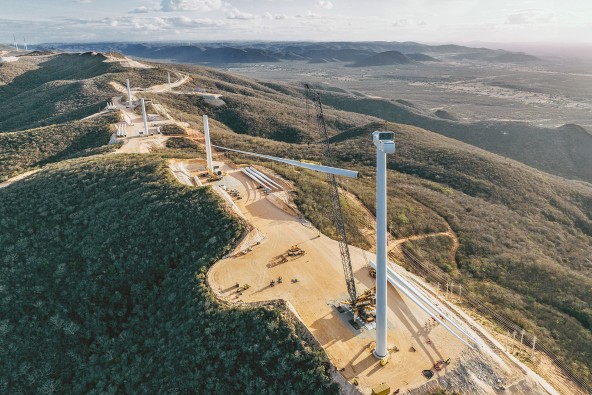
Sustainability
For over 75 years, the Liebherr Group has been focusing heavily on a large, continuously developing range of sophisticated products and services. The Group takes the associated responsibility for employees, the environment and society as a whole extremely seriously and views sustainability as an integral part of its core business and its corporate behaviour. As an independent and long-term-oriented, family-run company, Liebherr focuses on resource-efficient products, processes and infrastructure, prioritising safety, economic efficiency and environmental compatibility in all areas.

Corporate responsibility organisation
An organisational structure was established for the management and monitoring of sustainability-related issues. Strategic overall responsibility for corporate responsibility (CR) lies with the Liebherr-International AG holding company, whose administrative board represents the highest decision-making body. It is made up solely of members of the Liebherr family. The CR Advisory Board is the highest internal advisory body. Its members include the executive board of Liebherr-International AG, the managing directors of the divisional controlling companies as well as the representatives of the relevant group functions. At operational level, the CR Core Team is the work and exchange platform for all CR managers in the product segments as well as in the central departments concerned. In addition, subject-specific project groups and expert groups, whose members are experienced specialists, develop important CR-related issues and measures and are available to provide advice. Due to the wide range of external and internal requirements to which the Group is subject in this topic area, the Group therefore started to analyse improvements in its current CR organisation during the business year. Initial changes are expected to be implemented from 2026.
Sustainability strategy
In autumn 2023, Liebherr introduced its first sustainability strategy. As an economically, ecologically and socially sustainable company, its aim is to provide innovative solutions and improve the quality of life of present and future generations. The framework for Liebherr’s commitment to sustainable development and the respect of human rights is set out by the United Nations’ Sustainable Development Goals.
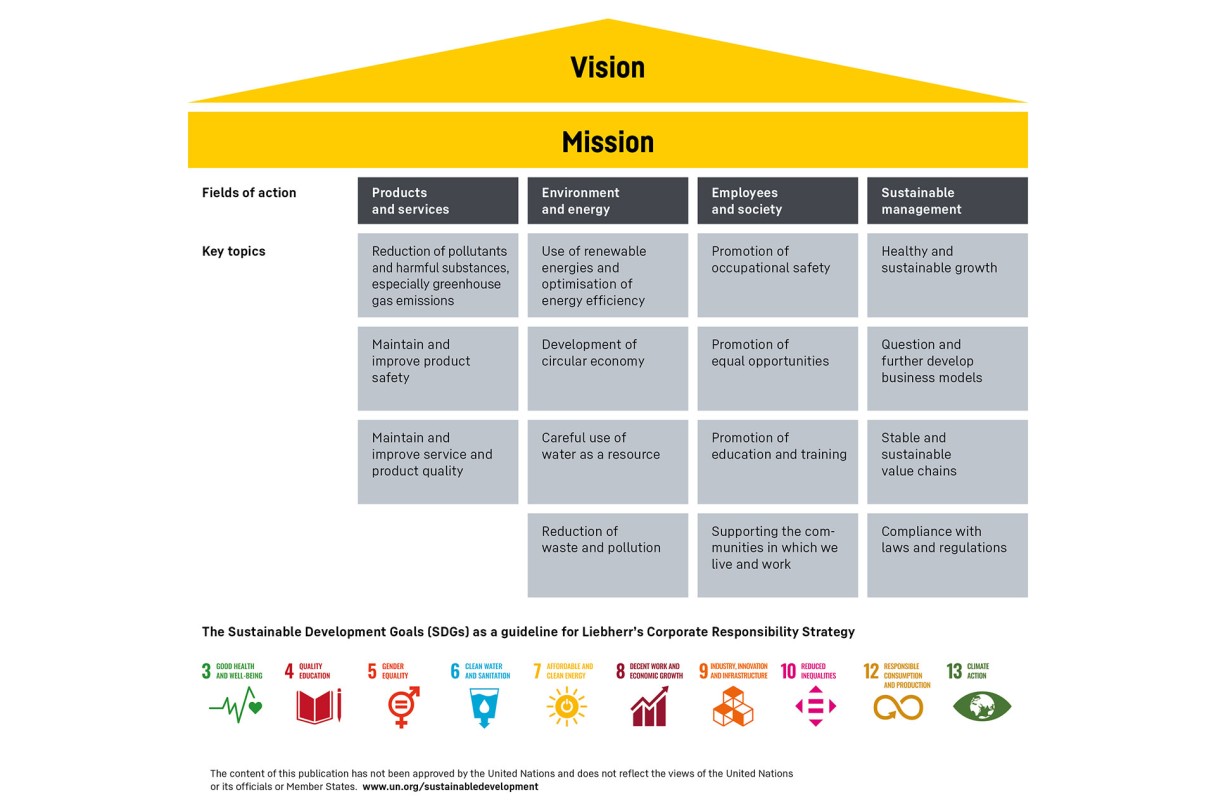
The sustainability strategy focuses on the four fields of action: products and services, environment and energy, employees and society, and sustainable management. During the business year, Liebherr began the gradual development of specific objectives and measures for implementation of the strategy, covering the following aspects, for example:
Reduction of pollutants
The Group is committed to the Paris Agreement on climate change. In future, it will disclose its climate goals and explain how they are consistent with the 1.5 °C target. During the business year, Liebherr began developing a transition plan for climate change mitigation. In future, this will explain the goals, measures and resources provided for the decarbonisation of the Group.
In 2022, Liebherr began to calculate its emissions throughout the Group according to scope 1 and scope 2 of the Greenhouse Gas Protocol (GHG). These represent the direct emissions from sources controlled by the company itself as well as the indirect emissions from the consumption of electricity, heat or refrigeration. Following the introduction of a tool, it has already been possible to significantly simplify the collection of the required data for the next two business years and significantly improve the data quality. Liebherr has continued to work on the systematic calculation of scope 3 emissions during the business year and has set up corresponding working groups for the scope 3 categories. These include all indirect emissions that occur along a company’s value creation chain, including upstream and downstream activities. At present, no reliable scope 3 figures can be published.
Scope 1 and scope 2 compared to the previous year 2023
| Type of emissions | tCO2e 2023 | tCO2e 2024 |
| Scope 1 | 116,364 | 110,768 |
| Scope 2, site-based | 122,507 | 122,438 |
| Scope 2, market-based | 58,025 | 49,080 |
| Total* | 174,389 | 159,848 |
| * The total results from the emissions of scope 1 and scope 2, market-based. | ||
Even today, Liebherr uses a variety of measures to adapt to climate change and reduce its ecological footprint. These include investing in carbon-efficient products and long-term research and development initiatives for low-emissions technologies. Some of the topics researched and developed include electric drives, hydrogen fuel cells and alternative fuels for combustion engines, for example hydrogen and ammonia. Existing technologies are continuously developed and optimised, while new and innovative machines, components and solutions that cause lower or no carbon emissions are also continuously added to the broad product portfolio every year.
Careful use of resources
Operational environmental and energy management is organised at a local level within the Liebherr Group. Related topics and measures are implemented worldwide according to the specific requirements of sites and production processes as well as their respective local legislation.
For the 2024 business year, data on water consumption at all sites worldwide was collected for the first time. An evaluation of the water data for the business year and the following year will show whether the previous decentralised and situational procedure in water management is adequate or whether Group-wide measures are required.
In light of the increasing focus on far-reaching safety, health and environmental standards, Liebherr established a comprehensive expert group on the topic area of health, safety and environment (HSE) during the business year. For the current 2025 business year, Liebherr will also collect data on waste management for the first time.
Ensuring stable and sustainable value-added chains
For Liebherr as a global family-run company with a strong value base, respect of human rights is an indispensable part of corporate responsibility and the corporate culture.
The German Supply Chain Due Diligence Act (LkSG), which came into force in Germany on 1 January 2023, has applied to eight German Liebherr companies since the 2024 business year. An internal group of experts supports and advises all companies on the implementation of the new requirements. Training courses and workshops have also been held. In this context, Liebherr also appointed and trained human rights officers, who monitor risk management in relation to the due diligence obligations addressed in the act.
The challenges and the sustainability standards to be met, not only in the supply chain but throughout the entire value chain, have increased during the business year. This was not only due to the company’s own orientation, but also the growing number of legal regulations and customer requirements. Experiences with the LkSG at the German sites will now be used to approach the topic of supply chain compliance in greater detail throughout the Group. This will also take into account the requirements of the future European Corporate Sustainability Due Diligence Directive (CSDDD), as well as the ‘omnibus’ regulation. This will combine existing and future regulations on sustainability reporting and limit the number of data points to be reported.
Numerous other countries within and outside the EU have also already introduced rules which are comparable to the German Supply Chain Due Diligence Act. Countries such as Norway, Canada, Australia or the United Kingdom also require companies to give verification every year of their commitment to the protection of human rights along the value chain. The Liebherr companies located in these countries submit legally required declarations to the national authorities and also publish them online on the company website. So, for example, the Liebherr sites in the United Kingdom have delivered a joint declaration on the Modern Day Slavery Act.

The finely ground lava stone perlite serves as the core material for Liebherr’s BluRoX insulation technology.
Promotion of equal opportunities and diversity
The Liebherr Group takes equal opportunities and diversity seriously and promotes a culture of respect and mutual appreciation. The company endeavours to create an inclusive working environment with equal opportunities for all employees, regardless of their origin, gender, age or other individual characteristics. In this type of environment, every employee has the opportunity to unfold their full potential. Liebherr advocates diversity in its management teams, so that different perspectives and experiences can be contributed to decision-making processes. The company also offers special talent promotion programmes, which are open to all employees as a matter of course. This includes mentoring programmes and targeted training offerings. Flexible working hours or the option of remote working encourage a healthy work-life balance and are intended to contribute towards employee satisfaction and motivation.
During the business year, Liebherr prepared a new female empowerment guideline, which has been available for application in Liebherr companies worldwide from January 2025. This is a voluntary undertaking by the respective boards of directors for the career advancement of women within the company. It includes establishing and supporting strong networks of women, promoting professional and personal development of female employees in management positions (e.g. through mentoring) as well as an annual planning conference at the level of managing directors. In addition, the further training offering will be enhanced with courses that also help promote female empowerment. Part-time management as well as shared or split management should also be supported.
Sustainability reporting
Another focus in this business year was the intensive preparations for future, comprehensive sustainability reporting at Group level. This included establishing and introducing the associated processes and tools as well as integrating them in the Group’s existing IT infrastructure.
It also included implementing the first double materiality assessment in accordance with the requirements of the European Union’s Corporate Sustainability Reporting Directive (CSRD), which was completed in spring 2024. This directive stipulates that in the future, companies must create comprehensive sustainability reports that cover the key topics and their impacts from an internal and external perspective: the impacts of the business activity on people, the environment and society as well as external aspects that could influence the financial performance of a company. Accordingly, 16 key topics were determined, on which Liebherr will report through various communication channels in the future. This is intended to highlight special projects and challenges and to create even more transparency.
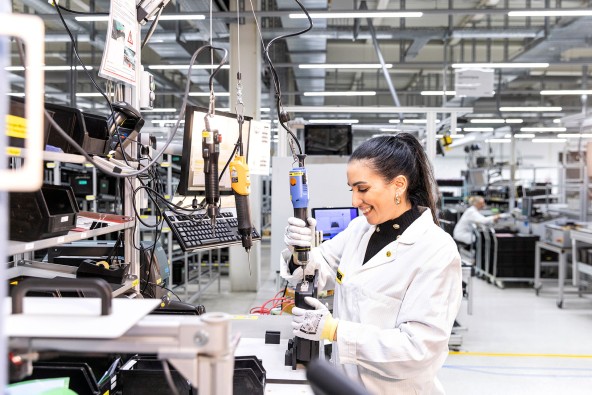
At Liebherr-Electronics and Drives GmbH in Lindau (Germany), an employee assembles a central computer that, among other functions, controls decentralised, external modules in various Liebherr machines.
Outlook for 2025
According to the International Monetary Fund, global economic growth is not expected to change much during the next two years. Growth of 3.3 % is expected both in 2025 and 2026. In industrialised countries a slight upturn at 1.9 % is expected, with stable growth of 4.2 % forecast for emerging market and developing economies. The World Bank forecasts slower growth over the next two years, but also predicts a stabilisation of the global economy. However, this growth will still not be sufficient to compensate for the various negative events of recent years.
The International Monetary Fund forecasts continued declining inflation, which will allow the central banks in the main industrial states to make further cuts to interest rates. Geopolitical tensions and global trade barriers will be the main drivers of developments in the coming months.
According to forecasts by the Euroconstruct research network at the start of the business year, European construction production fell by 2.4 % in 2024. A slight recovery is expected in 2025, with growth of 0.6 %. The European construction industry continues to face difficult times, not least due to high interest rates and energy prices as well as rising staffing costs.
In aerospace, global passenger transport at the end of 2024 had once again reached an all-time high, according to the International Air Transport Association (IATA). The upwards trend is expected to continue in 2025, albeit at a more moderate pace.
The above-mentioned challenges and trends have a direct impact on the Liebherr Group, with some industries facing not only high cost pressure to offer products and services at competitive prices, but also a challenging competitive landscape. Nonetheless, the Group is in a good position, globally speaking, with its innovative products and solutions, long-standing customer relationships and independently operating business units. There are also various opportunities, particularly in aerospace and the mining industry, as well as on the Australian and American markets.
The Group will even be able to compensate for fluctuations thanks to its high degree of diversification and decentralisation and its financial independence as a family-run company. The Liebherr Group therefore has a positive outlook for the future. For the current business year, the Group expects moderate growth with stable revenue distribution. Not least of all, it is the more than 50,000 employees worldwide who guarantee Liebherr’s long-term success through their valuable work.
Individual opportunities and risks
To describe individual opportunities and risks, similar types of these and their possible impacts have been grouped together.
In macroeconomic terms, opportunities can be found in the fact that many industrial countries face the need to renew their public infrastructure, which could lead to increased investments. At the same time, there are opportunities in the transition towards a carbon-neutral economy, which will be reflected in an increase in demand for the Liebherr Group’s products as a result of increasing investments. The Group’s incoming orders are following a continuously positive trend.
At the same time, however, there is overall economic uncertainty regarding the duration of the economic downturn in Germany and the future development of global, protectionist measures in world trade, which would affect the already strained supply chains. In this context, there is also a risk of volatility in the financial markets due to more restrictive monetary policy decisions, and a general tightening of financing terms.
The ongoing war in Ukraine brings with it continued uncertainty with regard to the long-term availability of energy and the development of the global economy.
In light of this, negative impacts on the Group’s activities cannot yet be ruled out.
In terms of possible economic performance risks, the Group faces changes in costs, particularly due to changes in energy or freight prices due to these uncertainties, but also due to significant climate or geopolitical shocks, which cannot always be compensated for by price indexation. The information technology (IT) used throughout the Liebherr Group is also becoming increasingly important for the Group, with the result that there is also always a risk of cyberattacks.
The chapters on each of the product segments contain detailed reports on the corresponding opportunities and risks.
Liebherr monitors these risks continuously and uses appropriate financial instruments to hedge selected transactions. The Group enters into financial transactions only where these are linked to its operational business activity or for hedging. In principle, Liebherr does not conduct transactions of a speculative nature.
The global orientation of the Group’s business activities, together with its broad product diversification and its embedded risk management system ensure that the relevant risks are kept under control. Based on currently available information, there are no further identifiable risks which could have a substantial detrimental effect on Liebherr’s assets, financial position and financial performance in the 2025 business year, and threaten the survival of the Group as a whole.

